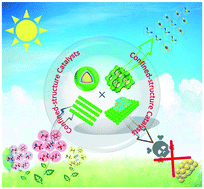A review of confined-structure catalysts in the catalytic oxidation of VOCs: synthesis, characterization, and applications
Abstract
With the rapid development of industries, VOC emissions harmful to the human body and the environment have also increased rapidly. At present, catalytic oxidation technology is regarded as one of the most promising methods to remove VOCs, which focuses on the reasonable design of the catalyst. Traditional catalysts often encounter problems such as non-uniform dispersion, high-temperature sintering, and poisoning of the active components, which influences the final performance of catalysts. Confined-structure catalysts can solve the above issues very well because the active phase can be fixed in the limited space to improve its dispersity and stability. In recent years, research in this area has become a hotspot. Therefore, this review firstly summarizes the synthetic method, characterization technology, and practical applications of the four most common confined-limited structures for the catalytic oxidation of VOCs: (a) core–shell structure, (b) channel packaging structure, (c) two-dimensional interface induced structure, and (d) defect-derived structure. Finally, the developmental perspectives and challenges of such catalysts are given.



 Please wait while we load your content...
Please wait while we load your content...